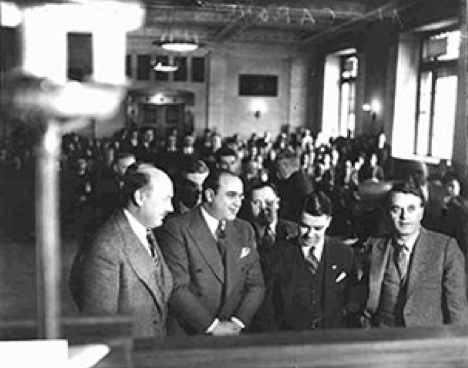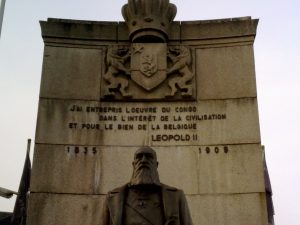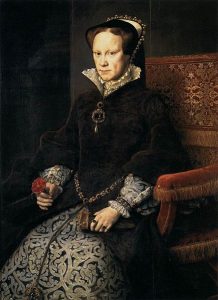About a month after the St. Valentine’s Day Massacre, which occurred in February of 1929, Al Capone and his lawyers were brought into George E. Q. Johnson’s office, the U.S. District Attorney assigned to Al Capone’s case, for questioning for the murder of six men who were allegedly a part of George “Bugs” Moran’s gang. Later in the day, long after Capone had left, an explosion occurred in the same room where Capone had been questioned. Johnson rushed into the room in total shock, knowing that he had been only a few rooms away from sudden death, and could have been yet another of Al Capone’s victims.1
Shortly after the Massacre, President Herbert Hoover was inaugurated President, and one of his first lines of action was to make sure Al Capone went to prison.2 He wanted to send the message that such “brazen criminology would no longer be allowed.”3 As a result, he appointed the top officials of every relevant agency, most importantly the Department of Treasury, to the case since their main focus was to get Al Capone for tax evasion. The Justice Department too was told to gather a group of agents, led by Eliot Ness, to get the crime in Chicago under control, especially the problem of bootlegging alcohol. Initially, Ness was having a lot of trouble, but as his approach became more aggressive, Al Capone became concerned. Capone attempted to bribe Ness and his men, hoping that they would stop disrupting his bootlegging business. Ness was not tempted by Capone’s gracious bribe, and because of that, he and his team were subsequently referred as “The Untouchables.”4

Although Al Capone was being watched and tracked by the government, his bootlegging business continued. Ness raided Al Capone’s brothers’ headquarters, Ralph Capone, and wire-tapped all of his telephones, hoping to receive information about where all of the breweries were. From that point on, the Untouchables destroyed more than $1 million worth of alcohol and equipment. Although they were able to gather much information about speakeasies, none of that information was used in court, unfortunately. Ness’ work was not a waste of time, however, due to his ability to track down many of Capone’s breweries and shut them down.
Another important group interested in bringing Capone to justice is a group called The Secret Six. This group was organized by Robert Randolph, president of the Chicago Association of Commerce. He solicited money from Chicago’s elite, who were afraid of Capone as well, to have the necessary funds to take Capone down. The Secret Six was in agreement with the government to not get involved with Al Capone’s specific crimes, but to help police enforce the law in Chicago. Since most of the crimes in Chicago were related to gang violence and Prohibition, they were able to reduce homicide rates related to these crimes. The Secret Six didn’t specifically participate in Al Capone’s trial, but they were able to save it and helped determine the outcome. They had the responsibility to protect key witnesses, such as Leslie Shumway and Fred Ries, for future trial dates.5
The U.S. Government was working hard to convict Al Capone, and as a result, Capone and his lawyers met with Johnson to discuss a plea bargain. On June 16, 1931, Capone agreed to plead guilty for tax evasion in return for a two-and-a-half year sentence. However, Judge Wilkerson did not approve the deal and denied the bargain on June 30. Capone then withdrew his guilty plea to take his chances with a trial.6 Several witnesses were brought to the stand in October of 1931, including Leslie Shumway, who provided a general ledger containing daily financial reports of liquor sales. Charles Arndt, Chief of Chicago’s Bureau of Internal Revenue, also testified that there was no record of Alphonso Capone paying his income tax. Lastly, Fred Reid testified that Capone was making huge profits, and that those profits were not recorded in any income statement. He said that they were wasted on gambling on horse racing and dog racing.7 According to data collected by the Department of Treasury, between the years 1924 and 1929, Al Capone had made roughly $1 million, and he therefore owed taxes amounting to roughly $215,000.8

During the trial, District Attorney Johnson showed the jury that Capone was successful, and that all the money from his businesses was going to him. Al Capone had extravagant spending habits, but all the money that he spent failed to appear on his income statement. He had expenses, such as fine food, expensive clothing, and a beautiful mansion in Palm Beach Florida. But how was Capone making all of this money? Johnson was able to show through evidence that his casinos and his speakeasies in Chicago were making large amounts of money. To make it inconspicuous, the profits earned were transferred to bank accounts in Miami, where Capone’s associates would pick them up for him.9
On October 11, Michael Ahern and Albert Fink, Al Capone’s lawyers, countered Johnson’s arguments. Ahern claimed that the government wasn’t coming at Al Capone because he wouldn’t pay his taxes. Rather, it was a surreptitious way to put him in jail for all the crimes that were allegedly connected to him. The government was trying to prove that Capone was making an abundance of money, and he failed to pay his taxes. Ahern claimed that his luxurious spending habits had no correlation in the context of the case.10
Many of the other key witnesses had yet to be called to the stand by Johnson, and Al Capone and his lawyers were anticipating that the feds were to put up as many as they could. However, as Johnson approached Judge Wilkerson, he said “Your honor, the government now rests,” leaving Al Capone and Ahern in shock. Ahern and Fink had intended for witnesses from all over to testify on Capone’s behalf, giving evidence of Capone and all of his massive losses due to gambling.11 The major premise of their case was to show that losses in gambling was not taxable; therefore, failure to pay taxes was just a mistake on account of it. They also tried to make the point known that there was no political reasoning behind this case, and that this was just an attempt to pin Capone for the failure to enforce Prohibition laws. Due to the suddenness of Johnson’s rest, Ahern and Fink were not prepared to call their first witnesses; they therefore requested a two-day delay. When Wilkerson denied their request, Ahern asked the judge for ten hours in front of the jury to present their defense, but the judge only granted them four.12

On October 15, 1931, court was in session again. Before the jury re-entered the court room, Ahern had a discussion with Wilkerson about permission to bring up certain points in the case. After Wilkerson denied his permission, Ahern angrily exclaimed that the Constitution was corrupt. He began to say to the jury that this case, again, was merely a way of blaming Capone for the lack of enforcement of Prohibition laws, saying that he was the cause of many gang related deaths. He ended by mentioning that Al Capone was forced to plead guilty for tax liability.
That night, Johnson contemplated what he would say the next morning. On October 16, Johnson began by giving the known fact that every American who exceeds an income of $1,500, must pay an income tax. He went for a simplistic approach by forgetting about all the other crimes that Al Capone had allegedly done in the past. It was simply a case of one man failing to pay his income tax. Johnson mocked Capone and compared him to a false Robin Hood.13 Johnson mentioned the time Capone bought $5,000 worth of diamond belt buckles, and $6,500 worth of meat. It didn’t go back to the poor though; it went to his lavish lifestyle in Florida.
It took the jury over eight hours to come to a verdict. On October 17, 1931 at 10:50 P.M., everyone was called back to court. Wilkerson took his position and asked, “Has the jury decided on the verdict?”14 They replied, “Yes your honor, we find the Defendant guilty on counts 1, 5, 9, 13, and 18, and not guilty on counts 2, 3, 4, 6, 7, 8, 10, 11, 12, 14, 15, 16, 17, 19, and 20.”15 Everyone in the courtroom stood in confusion, and Al Capone had a smirk.16 Capone was called back to court in the following week to receive his sentence. When the week had passed, the judge then repeated in court that Capone would serve five years for each felony, and would be charged $10,000 for each, and then another two years for each of the misdemeanors, with another charge of $10,000 each, in addition to the time that Al Capone had already spent in jail for contempt. Wilkerson subsequently lowered the sentence to eleven years and $50,000.
Finally, two years after the St. Valentine’s Day Massacre, George E. Q. Johnson had finally gotten what he had been working for.17 Unfortunately, he could not get him for all of the gang related violence that he had committed in the past, but he achieved not only his goal, but President Hoover’s as well. This could not have been done without the help from Eliot Ness, and all those who were able to gather information about Al Capone’s income history. This case would go down in history as one of the toughest cases in tax history.
- Dennis E. Hoffman, Scarface Al and the Crime Crusaders: Chicago’s private War against Capone (Chicago: Southern Illinois University Press, 1993), 158-163. ↵
- UXL Encyclopedia of World Biography, 2003, s.v. “Al Capone,” by Laura B. Tyle. ↵
- Dennis E. Hoffman, Scarface Al and the Crime Crusaders: Chicago’s private War against Capone (Chicago: Southern Illinois University Press, 1993), 25. ↵
- UXL Encyclopedia of World Biography, 2003, s.v. “Al Capone,” by Laura B. Tyle. ↵
- Dennis E. Hoffman, Scarface Al and the Crime Crusaders: Chicago’s private War against Capone (Chicago: Southern Illinois University Press, 1993), 296-299. ↵
- Fred D. Parsley, Al Capone: The biography of a self-made man (Freeport, New York: Books for libraries press, 1971), 4-6. ↵
- Dennis E. Hoffman, Scarface Al and the Crime Crusaders: Chicago’s private War against Capone (Chicago: Southern Illinois University Press, 1993), 314-316. ↵
- Encyclopedia of the Great Depression, 2004, s.v. “Al, Capone,” by Robert S. McElvaine. ↵
- Dennis E. Hoffman, Scarface Al and the Crime Crusaders: Chicago’s private War against Capone (Chicago: Southern Illinois University Press, 1993), 306-318. ↵
- Encyclopedia of the Great Depression, 2004, s.v. “Al, Capone,” by Robert S. McElvaine. ↵
- John Kobler, Capone: The Life and Times of Al Capone (New York: Da capo press, 2003), 1-10. ↵
- Jonathan Eig, Get Capone (Simon & Schuster, 2010), 240. ↵
- Jonathan Eig, Get Capone (Simon & Schuster, 2010), 248. ↵
- Jonathan Eig, Get Capone (Simon & Schuster, 2010), 257. ↵
- Jonathan Eig, Get Capone (Simon & Schuster, 2010), 257. ↵
- Jonathan Eig, Get Capone (Simon & Schuster, 2010), 251-258. ↵
- Jonathan Eig, Get Capone (Simon & Schuster, 2010), 297-300. ↵



54 comments
Iris Henderson
The story of Capone versus the Untouchables is epic. The author did a great job with their writing, truly captivating the reader. Ness and his team used strategy to thwart some of the illegal activities, or bootlegging alcohol, of Al Capone and his thugs. The help of the Secret Six was crucial, especially in terms of protecting key witnesses. After a complicated trial, the government finally got Capone for tax evasion.
Timothy ODekirk
This was a great article. Like I said in previous comments before, I am a huge fan of crime history but to be more specific, I am highly intrigued in gangster crime figures, such as Al Capone. The most intriguing point about this article for me, is the fact that Al Capone was a gangster who illegally sold Alcohol and held speakeasies, which was illegal at the time; however, alcohol now is legal. It’s just interesting to imagine a person who got sentenced to 11 years in prison for the bootlegging of alcohol, when achool is legal today. That blows my mind when I think of that, actually. Overall, this was an extremely interesting article, and worth the read. Well done.
Hannah Wilson
It is disappointing that Al Capone was never put into prison for all of the violence and even death that he had caused. However, it was clever to use his failure to pay taxes as his way in. A lot of violence was stopped when he was imprisoned. He is a big part of our nations history and he was a key player in the starting of gangs and violence. Great article.
Samuel Stallcup
I remember first hearing about Al Capone and thinking that just his name was pretty cool. As I started to read into him, I realized that he was a very interesting and different man. He was involved in plenty of ridiculous activities, such as tax evasion, and its interesting that he was able to escape some of these for SO long. I enjoyed this article because it reminded me of who this man was, and how he is an important part of history since we learned so much from his ways.
Julio Morales
It’s really a loss for the entire U.S when somebody like Al Capone gets 11 years in prison for tax evasion instead of his vicious crimes. It’s truly an injustice to all the people that died at the orders of Al Capone or himself. I feel that the U.S should have been more patient and used more surveillance to pin Al Capone on his other crimes. The entire U.S clearly knew what he did and the president at the time Herbert Hoover even made it one of his main goals and still they couldn’t get this guy for crimes that actually mattered. I don’t understand why they would settle for 11 years when they could have connected murders with him and put him away for life. In my opinion somebody just needed a win here and they settled.
Miguel Camarillo-Cohen
This was a fascinating article, I thought this was an interesting perspective to describe Al Capone’s criminal history through his trail. Considering that Al Capone is one of the most infamous gangsters in American History; it is ironic that out of all the criminal counts he received, the United States government was only able to convict him for tax evasion even though there was clear evidence of bootlegging.
Kayla Lopez
It is really crazy to me to know about all of the major crimes Al Capone committed and got away with. It is even worse to think that the reason he got caught was for tax evasion. This article was organized very well, was easy to follow, and we very enjoyable to read. The featured images also added to the story being told.
Rafael Lopez-Rodriguez
I have never heard about the story of Al Capone. I even had no idea who he was in the first place. After reading this article I think he should’ve spent the rest of his life behind bars. I think this is another story to prove that the legal system has to do a better job on giving these type of people what is right for society. But this was a very interesting article! I enjoyed reading it.
Max Lerma
Al Capone was an incredible figure in American history. He was feared, loathed, and yet his legacy is almost revered because of how many things he got away with. The only thing I knew about him was from the movie, “The Untouchables”, but this article filled in many details the movie could not capture. It remained interesting throughout its entire length and depicted how the government managed to win the court battle against Capone. This was a great read!
Hanadi Sonouper
Before reading this article, I did not have previous knowledge of who Al Capone was, but the author did a great job at telling the story of this particular criminal. I appreciate how the author detailed the story plot by plot, he was such a notorious man, and I believe the he did earn the nickname “Scarface.” It was interesting how he was big named businessman who attained notoriety during the prohibition era, but also a co-founder and boss of the Chicago Outfit. Overall it was an informative and enjoyable read.